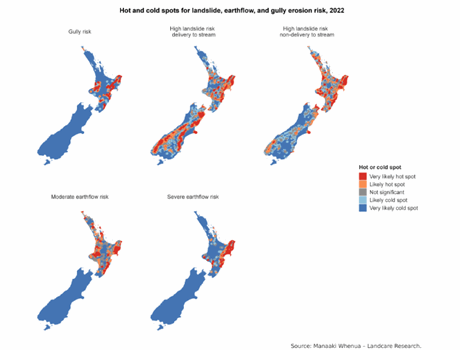 |
| Damage following Cyclone Gabrielle IMAGE: Gisborne District Council |
An estimated 182 million tonnes of eroded soil entered New Zealand’s rivers in 2022, according to new research.
Data from Stats NZ reveals the West Coast and Tairāwhiti had the highest levels of sediment movement into waterways, with 48 million tonnes and 36 million tonnes respectively.
Stuart Jones, Stats NZ environment and agricultural statistics senior manager, says New Zealand has high levels of soil erosion due to steep terrain, high rainfall, and earthquakes.
“While soil erosion is a natural process, it can be accelerated due to climatic conditions, or when human activities modify soil or vegetation, including from farming, construction, and mining.”
While soil erosion in the South Island is more likely due to high rainfall and vulnerable, steep, mountainous terrain, in the North Island it is due to the historical forest clearances on steep slopes for pastoral agriculture, the report says.

Nearly half of the Tairāwhiti region is at risk of erosion, making it by far the most at risk region ecologically. The region was devastated by flooding during Cyclone Gabrielle, which happened after this reporting period.
Manu Caddie, spokesperson for Mana Taiao Tairāwhiti, a group lobbying for sustainable land use in the region, says the report supports the growing consensus that land use in Tairāwhiti needs to urgently change.
“In 2022 we had the highest landslide risk and 36 millions tonnes of soil washed into waterways. With 2023 rainfall twice the volume of 2022 and three times the average, we know the landslide risk and soil loss will have been even higher than the data in this report.”
The group wants central government to recognise that the region is unique and needs a bespoke policy response. “We are still waiting on commitments from the new Government in response to the land use inquiry completed nearly a year ago,” Caddie says.
Caddie says that a key issue for the region is that rural property values are currently based on unsustainable land uses – like pasture and pine on erosion-prone slopes. But moving to more sustainable uses poses a political and financial challenge.
“Legal constraints coming on such practices will depreciate land values unless alternative income streams are quickly established or landowners compensated for a portion of the opportunity cost in retiring the land.”
Transitioning from pastoral farming and pine plantations to indigenous reforestation could also affect local employment and community cohesion if the transition isn’t supported by both public and private investment, Caddie says.
“There are a suite of policy options that will support a just transition in the region. Special Crown aid is required – and justified given the history of government policy in the region – for the rapid development of a climate-resilient, biodiverse, and prosperous region.”
Region-specific ETS changes?
Caddie wants to see region-specific Emissions Trading Scheme changes to incentivise sustainable permanent indigenous forests, as well as compensation schemes and payments for ecosystem services to incentivise sustainable land use practices – as proposed by the Recloaking Papatūānuku initiative presented at COP28.
“These are all policy options we need to have on the table right now. We need the Government to reduce the risk for investors willing and able to facilitate the transition.
“This can happen through accelerated commercial research and development of new products and services based on indigenous ecosystems, as well as ensuring co-funding and capital is available for new practices, new industries, and restructuring existing investments.”
Caddie wants to see collective action, with tailored public policy in response to the unique circumstances of the region and innovative financing mechanisms. “The Government, landowners and investors can pave the way for a resilient, biodiverse landscape that protects and enhances the wellbeing of the people and the place.”
- SEO Powered Content & PR Distribution. Get Amplified Today.
- PlatoData.Network Vertical Generative Ai. Empower Yourself. Access Here.
- PlatoAiStream. Web3 Intelligence. Knowledge Amplified. Access Here.
- PlatoESG. Carbon, CleanTech, Energy, Environment, Solar, Waste Management. Access Here.
- PlatoHealth. Biotech and Clinical Trials Intelligence. Access Here.
- Source: https://www.carbonnews.co.nz/story.asp?storyID=31148



